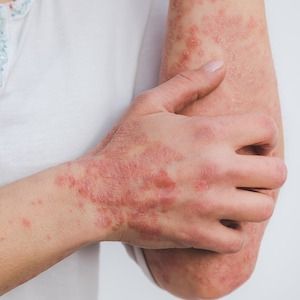Minimal Residual Lesions, Previous Biologic Failure Linked to Poor Patient-Reported Psoriasis Outcomes
These data highlight the elements known to impact patient-reported outcomes among those with psoriasis and successful clinician-reported outcomes following biologic use.

Both minimal residual skin lesions and previous failure of treatment with biologics are linked to poorer patient-reported outcomes among those with psoriasis, according to new findings, and choosing a biologic with the highest predicted effectiveness may be the optimal strategy for such patients.1
These conclusions were the result of a recent retrospective and observational study conducted with the purposes of highlighting whichever factors impacted psoriasis patients’ patient-reported outcomes, specifically among individuals who have had clinician-reported outcomes which were deemed successful following biologic use.
This research was led by Won Ji Song, of the department of dermatology at Seoul National University Hospital in Seoul, Korea. Song and colleagues noted the importance of bridging the gap observed between patients and physician views on outcomes, especially given that both are currently seen as essential for the achievement of success in treatment.2
“In light of these considerations, the objective of our study was to investigate patient-reported outcomes assessed using the DLQI in patients with chronic plaque psoriasis who achieved promising clinician-reported outcomes following biologic treatments,” Song and colleagues wrote. “Additionally, we explored the factors associated with patient-reported outcomes to shed light on why achieving clear skin does not always equate to holistic well-being.”
Background and Methods
The investigators conducted their retrospective observational research into medical data at the Seoul National University (SMG-SNU) Boramae Medical Center, an academic facility, and their work took place from December 2022 - May 2023. The research team involved participants in the age range of ≥18 years with a chronic plaque psoriasis diagnosis and a noted positive response to current biologic therapy for more than 6 months at SMG-SNU.
If subjects had records of Psoriasis Area and Severity Index (PASI) scores, Dermatology Life Quality Index (DLQI) scores, and data on residual lesion locations identified during the same day of their visit, they could be included in the study. DLQI was implemented as a means to look into patient-reported outcomes, specifically.
To address questions on patients’ DLQI, the questionnaire featured a total of 10 inquiries, with each being rated on a scale of 0 - 3, with 0 meaning strongly disagreeing and 3 meaning strongly agreeing. The total score had a range from 0 - 30, and those on the higher end suggested a more profound impact on subjects’ quality of life.
Additionally, the research team noted that 0 or 1 in the questionnaire suggested minimal effects and scores over 2 suggested a substantial negative effect. Those who were included in the team’s research were evaluated through a validated Korean version of the DLQI questionnaire.
The investigators also highlighted participants’ sex, baseline PASI score, body mass index (BMI), age, prior biologic treatment failure history, current biologic treatment duration, total duration of biologic treatment, and any related comorbidities.
Findings
The investigators concluded their research with 96 subjects who had reported major PASI score improvement and at least 6 months of biologics. They found that the median PASI score among these individuals had been 0.4, with 37.5% having gotten to PASI 100.
About 47.9% of the subjects noted that their disease had had minimal or no effect on their DLQI, but 52.1% suggested there had been a negative impact as a result of the condition. A unique finding the research team were able to uncover was that 28.1% had experienced biologic treatment failure previously, which had been defined as the inability of said patients to achieve or maintain PASI 75 using the biologic agent they had implemented.
The investigators’ multivariable logistic regression suggested that there was a notable positive correlation observed in the study between subjects’ achievement of PASI 100 and their reporting of no major impact on life quality (adjusted odds ratio [aOR] 3.88, 95% confidence interval [CI] 1.49–10.91, P = .007). However, the team also found that a history of treatment failure with biologics was linked to a negative effect on subjects’ quality of life due to the skin disease (aOR 0.13, 95% CI 0.02–0.65, P = .023).
Additionally, among those who were shown to have PASI 100, individuals who had had prior biologic treatment failure were found to have reported a much lower life quality that that of subjects without such a history (P = .033).
The investigators highlighted some of the study’s limitations, including the retrospective nature of their work and the consequently smaller size of the sample and the lack of data on patients simultaneously being given psychiatric treatment. They also noted that, as DLQI scores had been evaluated cross-sectionally, reaching a strong conclusion was avoided as far as the temporal evolution of outcomes.
“To achieve genuine treatment success aligned with patient perspectives, it is crucial not only to target PASI 100 but also to opt for a biologic agent with the highest predicted efficacy,” they wrote. “This approach is preferable over a “step-up” strategy, which carries a higher risk of treatment failure.”
References
- Song WJ, Yoon H-S. Impact of residual skin lesions and previous biologic treatment failure on patient-reported outcomes in patients with psoriasis receiving biologic treatment. J Dermatol. 2024; 00: 1–7. https://doi.org/10.1111/1346-8138.17249.
- Barbieri JS, Gelfand JM. Patient-reported outcome measures as complementary information to clinician-reported outcome measures in patients with psoriasis. JAMA Dermatol. 2021; 157: 1236–1237.